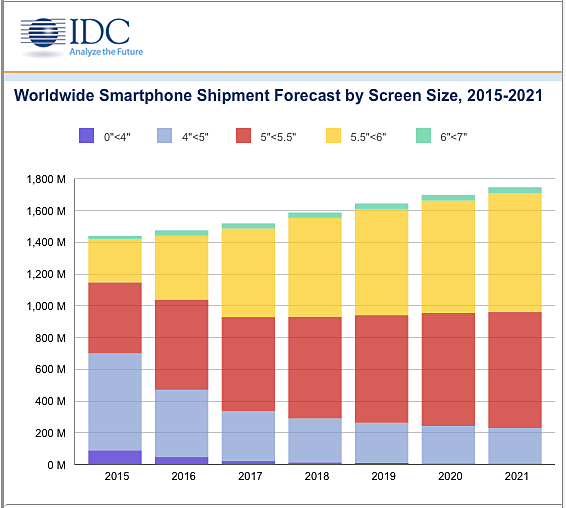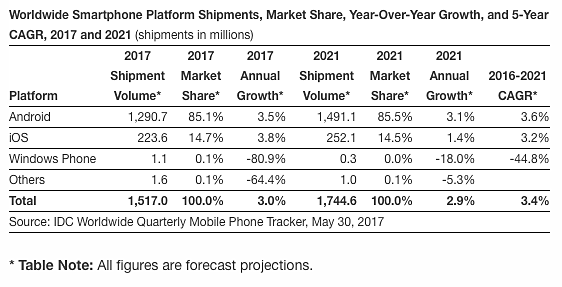After Slow 2016, Smartphone Shipment Volume Recovery Expected In 2017 Gaining Momentum Into 2018 – IDC
According to a new forecast from the International Data Corporation (IDC) Worldwide Quarterly Mobile Phone Tracker, worldwide smartphone shipments are expected to rebound slightly in 2017 with expected growth of 3.0% over the previous year. Year-over-year growth in 2016 was 2.5%, marking the lowest growth the industry has ever experienced.
With several major devices entering the market this year, IDC anticipates shipment volumes will grow to 1.52 billion in 2017. And IDC expects this momentum to carry into 2018, when smartphone shipments are forecast to grow 4.5% year over year, fueled by improved economic conditions in many emerging markets and a full year of new iPhone shipments from Apple.
“2016 was an interesting year for smartphones with some high-growth markets down and other mature markets like the U.S. and China outpacing global growth rates,” said Ryan Reith, program vice president with IDC’s Worldwide Quarterly Mobile Device Trackers. “Looking ahead, we continue to believe several factors will enable the smartphone market to regain some of its momentum. First and foremost is that less than half the world’s population is currently using a smartphone, and markets like the Middle East & Africa, Central & Eastern Europe, and Southeast Asia still have plenty of room to grow. In addition, as consumers continue to demand more from their smartphones we expect to see a large portion of the installed base that is currently using low-end devices begin to seek a more robust experience on more capable devices. Media consumption, gaming, augmented and virtual reality, and constant connectivity are drivers of this trend.”
The other big topic in the smartphone industry is the intense fight for the high end of the market. Samsung has made a lot of noise with its recent Galaxy S8 and S8+ device launches, further proving that last year’s Note 7 debacle is not going to alter the company’s plans for remaining number one. And all signs point to late 2017 being one of Apple’s biggest, if not the biggest, product announcements with the highly anticipated next round of iPhones. Despite the massive growth of the low-end smartphone market in the past few years, IDC still fully expects the high-end market will continue to hold its place in the industry. Advancements in computing, display technology, cameras, and storage will continue to create the need for high-end users to refresh their devices.
“With the ongoing fight at the high end, vendors will need to find a way to innovate ahead of the curve to attract new users and increase shipments while driving profits,” said Anthony Scarsella, research manager with IDC’s Worldwide Quarterly Mobile Phone Tracker. “The display looks like it could be the next battlefield for the smartphone over the next couple years. We have seen both Samsung and LG opt for new borderless 18:9 displays and Apple could be set to join the party later this year. As smartphone owners continue to consume media on their devices, the screen (bigger, brighter, and bolder) will be an integral part of the overall design language for each vendor. From flexible to foldable and everything between, 18:9 displays look to be just the beginning of what’s to come.”
Platform Highlights
Android: The discussion around Android’s share of the smartphone market became irrelevant a few years back when it became clear that devices running Google’s OS would continue to capture roughly 85% of the worldwide smartphone volume. What is interesting is to look at the many micro-trends going on within the platform. Despite a slew of very attractive high-end Android products, IDC continues to see Android average selling prices (ASPs) decline and expectations are that the 1.5 billion Android phones that ship in 2021 will have a collective ASP of $198. Looking closer at 2018, the Middle East & Africa region for Android devices is expected to be the fastest growing at 10% year over year, which will well outpace the forecast for worldwide growth of 4.1%.
iOS: Coming off the first year in which iPhone shipments declined, expectations are that 2017 volumes will grow 3.8%. IDC slightly lowered its 2017 projections for Apple in this forecast to 223.6 million, while increasing its 2018 volumes to 240.4 million. All signs point to late 2017 and certainly 2018 being very strong for Apple as much of its installed base seems ready for a refresh and the next round of iPhones is not likely to disappoint its fans.
Windows Phone: Windows Phone shipments continue to fall as the lack of new hardware partners, developer support, and overall enthusiasm for the platform show no immediate signs of recovery. IDC expects 2017 volumes to decline 80.9% to just 1.1 million units. Microsoft has yet to fully commit to any “Surface”-style attack for smartphones or to push new vendors to embrace the platform, leaving little hope of mounting a full scaled comeback in the years to come.
To learn more about IDC, visit:
http://www.idc.com
Source: IDC


